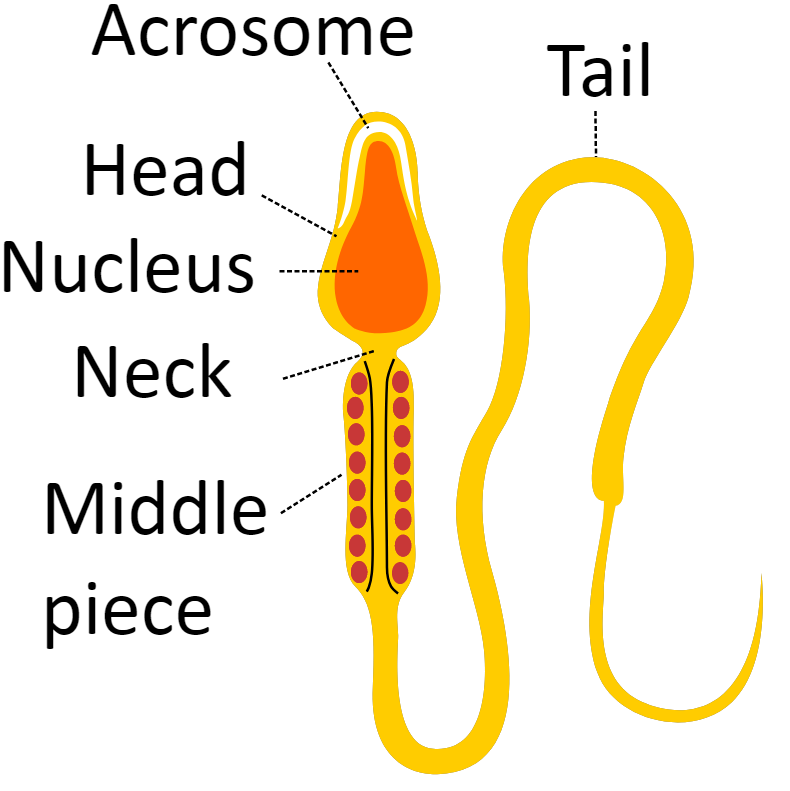
What is the function of the tail of human sperm?
Answer
382.2k+ views
Hint: In anisogamous forms of sexual reproduction, sperm is the male reproductive cell, or gamete (forms in which there is a larger, female reproductive cell and a smaller, male one). Animals produce spermatozoa, which are motile sperm with a flagellum tail, whereas red algae and fungi produce spermatia, which are non-motile sperm cells.
Complete answer:
The human gamete consists of three main parts: head, middle piece, and tail. The foremost operation of the tail is to provide motility to the gamete. With its whipping movement, it propels the gamete towards the egg.
The tip of the gamete head is that portion mentioned because of the process that permits the gamete to penetrate the egg. The midpiece contains the mitochondria that provide the energy the tail must move. The tail moves with whip-like movements back and forth to propel the gamete towards the egg.
The tail provides sperm movement. It whips and undulates so that the cell will travel the egg. Following gamete deposition within the female generative tract, activation of tail movement is suppressed till the gamete is carried to at intervals a relatively short distance of the egg.

Thus, The tail's primary function is to provide sperm motility. It propels the sperm towards the egg with its whipping motion.
Note:
Sperm cells are unable to divide and have a short lifespan, but after fusing with egg cells during fertilization, a new organism emerges, beginning as a totipotent zygote. Human sperm cells are haploid, which means that their 23 chromosomes can join with the 23 chromosomes of the female egg to form a diploid cell with 46 paired chromosomes.
Complete answer:
The human gamete consists of three main parts: head, middle piece, and tail. The foremost operation of the tail is to provide motility to the gamete. With its whipping movement, it propels the gamete towards the egg.
The tip of the gamete head is that portion mentioned because of the process that permits the gamete to penetrate the egg. The midpiece contains the mitochondria that provide the energy the tail must move. The tail moves with whip-like movements back and forth to propel the gamete towards the egg.
The tail provides sperm movement. It whips and undulates so that the cell will travel the egg. Following gamete deposition within the female generative tract, activation of tail movement is suppressed till the gamete is carried to at intervals a relatively short distance of the egg.

Thus, The tail's primary function is to provide sperm motility. It propels the sperm towards the egg with its whipping motion.
Note:
Sperm cells are unable to divide and have a short lifespan, but after fusing with egg cells during fertilization, a new organism emerges, beginning as a totipotent zygote. Human sperm cells are haploid, which means that their 23 chromosomes can join with the 23 chromosomes of the female egg to form a diploid cell with 46 paired chromosomes.
Recently Updated Pages
What percentage of the area in India is covered by class 10 social science CBSE

The area of a 6m wide road outside a garden in all class 10 maths CBSE

What is the electric flux through a cube of side 1 class 10 physics CBSE

If one root of x2 x k 0 maybe the square of the other class 10 maths CBSE

The radius and height of a cylinder are in the ratio class 10 maths CBSE

An almirah is sold for 5400 Rs after allowing a discount class 10 maths CBSE

Trending doubts
Write an application to the principal requesting five class 10 english CBSE

Difference between mass and weight class 10 physics CBSE

What is Commercial Farming ? What are its types ? Explain them with Examples

What are five examples of facts and opinions class 10 english CBSE

Which state has the longest coastline in India A Tamil class 10 social science CBSE

10 examples of evaporation in daily life with explanations




